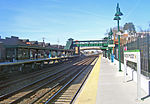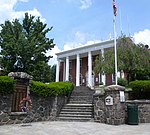Ever Rest
AC with 0 elementsArt museums and galleries in New York (state)Artists' studios in the United StatesBiographical museums in New York (state)Historic American Buildings Survey in New York (state) ... and 6 more
Historic house museums in Westchester County, New YorkHouses completed in 1832Houses on the National Register of Historic Places in New York (state)National Register of Historic Places in Westchester County, New YorkNew York (state) museum stubsWestchester County, New York Registered Historic Place stubs

Ever Rest is the home and studio of Jasper F. Cropsey, a painter in the Hudson River School. The historic house museum is located in Hastings-on-Hudson, New York and was built in 1835. Cropsey acquired the property in 1886 and built an artist studio addition which was completed in 1888. It is owned and managed by Newington-Cropsey Foundation which preserves the house and the work of Cropsey.It was added to the National Register of Historic Places in 1973.
Excerpt from the Wikipedia article Ever Rest (License: CC BY-SA 3.0, Authors, Images).Ever Rest
Washington Avenue,
Geographical coordinates (GPS) Address Nearby Places Show on map
Geographical coordinates (GPS)
| Latitude | Longitude |
|---|---|
| N 40.993055555556 ° | E -73.881944444444 ° |
Address
Washington Avenue 49
10706
New York, United States
Open on Google Maps







